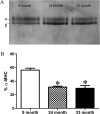Effect of aging on power output properties in rat skinned cardiac myocytes
- PMID: 21896503
- PMCID: PMC3210961
- DOI: 10.1093/gerona/glr150
Effect of aging on power output properties in rat skinned cardiac myocytes
Abstract
Aging is generally associated with a decline in several indices of cardiac function. The cellular mechanisms for this decline are not completely understood. The ability of the myocardium to perform external work (power output) is a critical aspect of ventricular function. The purpose of this study was to determine the effect of aging on loaded shortening and power output properties. We measured force-velocity properties in permeabilized (skinned) myocytes from the hearts of 9-, 24-, and 33-month-old male Fisher 344 × Brown Norway F1 hybrid rats (F344BN) during loaded contractions using a force-clamp technique. Power output was calculated by multiplying force and shortening velocity values. We found that peak power output normalized to maximal force was significantly decreased by 18% and 31% in myocytes from 24- and 33-month-old group, respectively, compared with 9-month group (p < .05). These results suggest that aging is associated with a significant decrease in the ability of the myocardium to do work.
Figures



Similar articles
-
Altered single cell force-velocity and power properties in exercise-trained rat myocardium.J Appl Physiol (1985). 2003 May;94(5):1941-8. doi: 10.1152/japplphysiol.00889.2002. Epub 2003 Jan 10. J Appl Physiol (1985). 2003. PMID: 12524379
-
Sarcomere length dependence of rat skinned cardiac myocyte mechanical properties: dependence on myosin heavy chain.J Physiol. 2007 Jun 1;581(Pt 2):725-39. doi: 10.1113/jphysiol.2007.128199. Epub 2007 Mar 8. J Physiol. 2007. PMID: 17347271 Free PMC article.
-
Inorganic phosphate speeds loaded shortening in rat skinned cardiac myocytes.Am J Physiol Cell Physiol. 2004 Aug;287(2):C500-7. doi: 10.1152/ajpcell.00049.2004. Epub 2004 Apr 14. Am J Physiol Cell Physiol. 2004. PMID: 15084471
-
Power output is linearly related to MyHC content in rat skinned myocytes and isolated working hearts.Am J Physiol Heart Circ Physiol. 2005 Aug;289(2):H801-12. doi: 10.1152/ajpheart.01227.2004. Epub 2005 Mar 25. Am J Physiol Heart Circ Physiol. 2005. PMID: 15792987
-
Effect of age on cardiac excitation-contraction coupling.Clin Exp Pharmacol Physiol. 2010 Jan;37(1):1-7. doi: 10.1111/j.1440-1681.2009.05276.x. Epub 2009 Aug 4. Clin Exp Pharmacol Physiol. 2010. PMID: 19671063 Review.
Cited by
-
Circulating factors induced by caloric restriction in the nonhuman primate Macaca mulatta activate angiogenic processes in endothelial cells.J Gerontol A Biol Sci Med Sci. 2013 Mar;68(3):235-49. doi: 10.1093/gerona/gls158. Epub 2012 Aug 17. J Gerontol A Biol Sci Med Sci. 2013. PMID: 22904098 Free PMC article.
-
Pregnancy late in rodent life has detrimental effects on the heart.Am J Physiol Heart Circ Physiol. 2018 Sep 1;315(3):H482-H491. doi: 10.1152/ajpheart.00020.2018. Epub 2018 May 11. Am J Physiol Heart Circ Physiol. 2018. PMID: 29750565 Free PMC article.
-
A high-whey-protein diet does not enhance mechanical and structural remodeling of cardiac muscle in response to aerobic exercise in rats.Phys Act Nutr. 2022 Mar;26(1):28-38. doi: 10.20463/pan.2022.0005. Epub 2022 Mar 31. Phys Act Nutr. 2022. PMID: 35510443 Free PMC article.
-
Age-associated proinflammatory secretory phenotype in vascular smooth muscle cells from the non-human primate Macaca mulatta: reversal by resveratrol treatment.J Gerontol A Biol Sci Med Sci. 2012 Aug;67(8):811-20. doi: 10.1093/gerona/glr228. Epub 2012 Jan 4. J Gerontol A Biol Sci Med Sci. 2012. PMID: 22219513 Free PMC article.
-
Growth hormone and IGF-1 deficiency exacerbate high-fat diet-induced endothelial impairment in obese Lewis dwarf rats: implications for vascular aging.J Gerontol A Biol Sci Med Sci. 2012 Jun;67(6):553-64. doi: 10.1093/gerona/glr197. Epub 2011 Nov 10. J Gerontol A Biol Sci Med Sci. 2012. PMID: 22080499 Free PMC article.
References
-
- Brenner DA, Apstein CS, Saupe KW. Exercise training attenuates age-associated diastolic dysfunction in rats. Circulation. 2001;104(2):221–226. - PubMed
-
- Wanagat J, Wolff MR, Aiken JM. Age-associated changes in function, structure and mitochondrial genetic and enzymatic abnormalities in the fisher 344 x brown Norway F1 hybrid rat heart. J Mol Cell Cardiol. 2002;34:17–28. - PubMed
-
- Boluyt MO, Converso K, Hwang HS, Mikkor A, Russell MW. Echocardiographic assessment of age-associated changes in systolic and diastolic function of the female F344 rat heart. J Appl Physiol. 2004;96(2):822–828. - PubMed
-
- Iemitsu M, Miyauchi T, Maeda S, et al. Exercise training improves cardiac function-related gene levels through thyroid hormone receptor signaling in aged rats. Am J Physiol Heart Circ Physiol. 2004;286(5):H1696–H1705. - PubMed
-
- Hacker TA, McKiernan SH, Douglas PS, Wanagat J, Aiken JM. Age-related changes in cardiac structure, function, and morphology in Fischer 344 x Brown Norway hybrid rats. Am J Physiol Heart Circ Physiol. 2005;290(1):H304–H311. - PubMed
Publication types
MeSH terms
Substances
Grants and funding
LinkOut - more resources
Full Text Sources
Medical

